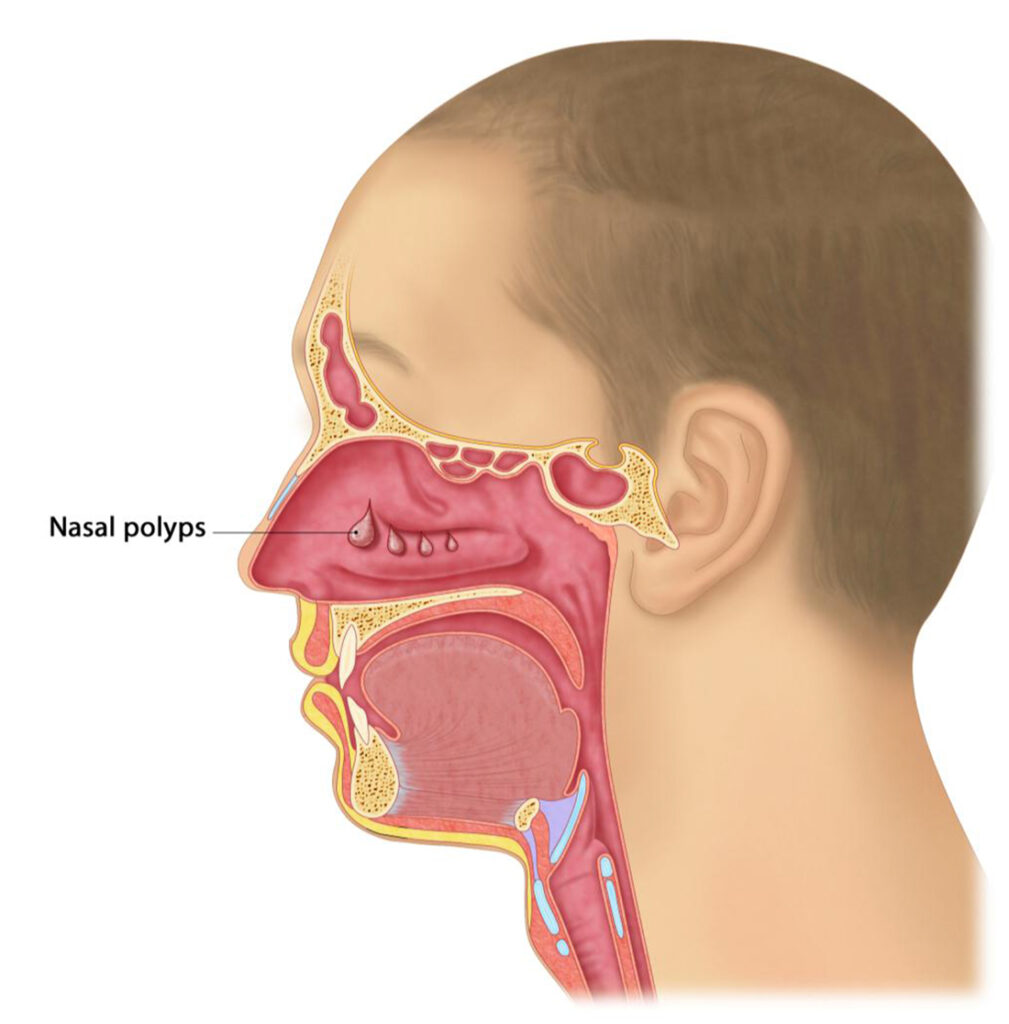Chronic rhinosinusitis with nasal polyposis (CRSwNP) is a persistent inflammatory condition of the nasal and sinus mucosa, characterized by the growth of benign polyps within the nasal cavity and sinuses. This condition affects approximately 2–4% of the global population, significantly impairing quality of life due to symptoms like nasal obstruction, facial pressure, anosmia (loss of smell), and persistent nasal discharge.

Causes and Pathophysiology of CRSwNP
The development of CRSwNP is linked to chronic inflammation driven by both environmental and genetic factors. Common triggers include:
Immune Dysregulation: T-helper 2 (Th2) inflammation dominates, resulting in elevated levels of interleukins (IL-4, IL-5, IL-13) and increased eosinophil activity.
Signs and Symptoms
Allergens: Dust mites, pollen, and molds.
Infections: Recurring upper respiratory tract infections.
Aspirin-Exacerbated Respiratory Disease (AERD): A triad of asthma, aspirin sensitivity, and nasal polyposis.
CRSwNP presents with a range of symptoms, which persist for 12 weeks or longer:
- Nasal Congestion: Persistent blockage due to polyp growth.
- Rhinorrhea: Clear or purulent nasal discharge.
- Facial Pain or Pressure: Often localized over the affected sinuses.
- Hyposmia or Anosmia: Partial or total loss of smell.
- Postnasal Drip: Mucus flowing down the throat.
Diagnostic Criteria and Procedures
Diagnostic Criteria
The diagnosis of CRSwNP requires the presence of at least two of the following symptoms for over 12 weeks, alongside endoscopic or imaging confirmation:
- Nasal obstruction.
- Nasal discharge.
- Reduced or absent sense of smell.
- Facial pain or pressure.
Diagnostic Tools
- Nasal Endoscopy: Visualization of polyps and inflammation.
- CT Scan: Detailed imaging to assess sinus involvement and rule out structural abnormalities.
- Allergy Testing: Identifies specific allergens contributing to inflammation.
- Biopsy: Rarely required, but used to exclude neoplastic conditions.
Treatment Options for CRSwNP
Medical Management
- Intranasal Corticosteroids (INCS): First-line therapy to reduce inflammation and polyp size.
- Examples: Fluticasone, budesonide, mometasone.
- Oral Corticosteroids: Used for severe or refractory cases.
- Biologic Therapies: Monoclonal antibodies targeting specific inflammatory pathways, such as:
- Dupilumab: Blocks IL-4 and IL-13.
- Mepolizumab: Inhibits IL-5 activity.
- Saline Irrigation: Helps clear mucus and allergens.
Surgical Management
For patients with recurrent or severe symptoms despite medical therapy, functional endoscopic sinus surgery (FESS) is performed to:
- Remove polyps.
- Open sinus pathways for better drainage.
- Enhance drug delivery to inflamed mucosa.
Prevention and Lifestyle Modifications
- Avoid Triggers: Minimize exposure to known allergens and irritants.
- Manage Comorbidities: Proper control of asthma or allergic rhinitis.
- Practice Good Nasal Hygiene: Regular saline irrigation to clear debris and mucus.
- Follow Up: Regular check-ups to monitor disease progression and adjust treatments.
Prognosis and Long-Term Outlook
Although CRSwNP is a chronic condition with a tendency to recur, advancements in medical and surgical treatments have significantly improved patient outcomes. Early diagnosis and a personalized treatment plan are essential for achieving optimal symptom control and preventing complications, such as recurrent infections or orbital cellulitis.